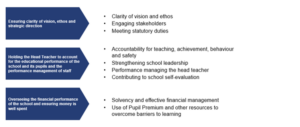Education governance has changed rapidly over recent years and the role of school and academy governance has never been so pivotal in ensuring the improvement of educational performance and opportunities for all children.
Governing and trust boards are made up of people from a variety of backgrounds who can contribute their skills and experience to what is one of the most important voluntary roles in schools and academies. Through their strategic leadership, boards are key to improving performance and ensuring that resources are used effectively so that every child has the best possible education.
The framework for inspection reflects the importance of the role of governors and, through inspection, Ofsted have identified that evidence indicates that there is a relationship between effective governance, the quality of leadership and management, and the quality of provision and pupil achievement.
The governing or trust board has the overall responsible for making key decisions alongside the executive leadership team, who are responsible for the day to day management of the school. In academy and multi-academy trusts, some of these decisions may have been be delegated to local governing boards or trust committees. It is important to recognise the difference between the board’s strategic role and the executive leaders management role.
The roles and responsibilities of a governing and trust boards differ slightly and are broken down as follows:
Academy Trust Board

Maintained Governing Board
Challenge and Support
The term ‘challenge and support’ is a term used frequently in relation to governance. In conducting their roles, governors and trustees should not be afraid to ask challenging questions of the executive leadership team about the performance of the school; however, this should be done in a supportive and productive manner. They need to be as knowledgeable as possible in order for them to make the right decisions concerning school policy and procedure.
Strategic Direction
The board are there to build the foundations for robust policies and processes within which its work can be conducted effectively and with suitable internal checks and accountabilities. In order to do this there has to be a vision and an aim for the school; a strategic direction.
To establish this direction the board should:
- Decide what it wants the school to achieve and set the framework for getting there.
- Agree the vision, values, ethos, plans, policies and targets and review progress
- Agree the school improvement strategy
- Monitor and evaluate the work of the school
- Oversees the self-evaluation process
Whilst the board has a strategic function, the executive leader is responsible for the internal organisation, management and control of the school or academy. It is vital that the board develops an effective relationship with the executive leader who will provide valuable information on the performance of the school. In the majority of schools and academies, the executive leader chooses to be a member of the governing, local or trust board and therefore will have a dual role. In the position of governor or trustee they are part of the strategic planning body within the school and in their role as executive leader they are responsible for implementing the strategic framework agreed by the board.
The board requires the executive leader to provide relevant material on data and performance, but governors and trustees should not rely on this as a sole means of information. They should be able to demonstrate their ability to seek out information for themselves using resources such as ASP (Assessing School Performance) or the Ofsted IDSR (Inspection Data Summary Report). Challenging the executive leadership team on this data and holding them to account is a tool for improvement which will benefit the school as a whole.
Accountability
The executive leader in their operational role has a clear responsibility for managing the school on a daily basis. It is the executive leader who is ultimately accountable to the board for a school or academy that runs smoothly with staff working effectively, rules and procedures followed and were children are happy and safe. The executive leader is also responsible for the quality of teaching and learning and, as the manager of this complex environment he or she communicates on the school’s behalf with the parents and other partners involved with the school.
The board in their strategic role works with the executive leader to plan the strategic direction of the school and ensures that the policies and procedures in place are effective. The overall legal responsibility for this rests with the board and not with individual governors. In deciding the strategic direction, the board should also communicate and take into account the views of parents and partners.





